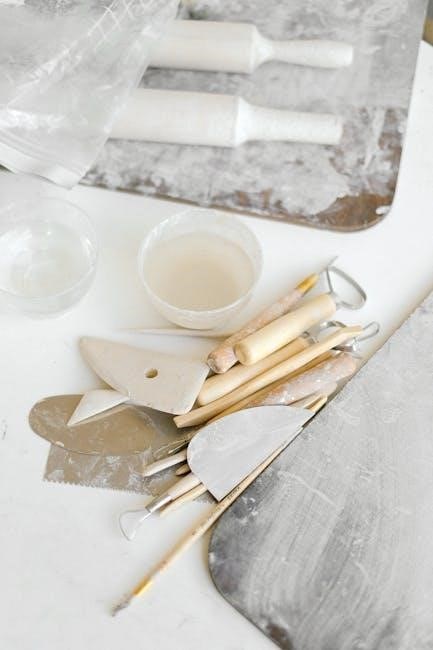The C4 Corvette manual swap is a popular modification among enthusiasts‚ offering enhanced driving experience and performance. It involves replacing the automatic transmission with a manual one‚ requiring specific parts and technical expertise. This swap allows drivers to enjoy better control and engagement‚ making it a rewarding project for car enthusiasts.
Background of the C4 Corvette
The C4 Corvette‚ produced from 1984 to 1996‚ marked a significant evolution in Chevrolet’s iconic sports car lineup. Known for its sleek design and advanced technology‚ the C4 introduced features like a digital instrument cluster and a rear suspension with transverse fiberglass leaf springs. While automatic transmissions were standard‚ manual transmissions gained popularity among enthusiasts for their performance potential. The C4 also saw the introduction of the ZF6 six-speed manual transmission in 1989‚ a notable upgrade for drivers seeking better control. The C4’s blend of power‚ handling‚ and style made it a favorite‚ but its automatic transmissions often limited driver engagement. This led many owners to explore manual swaps‚ enhancing both performance and driving experience. The C4’s legacy as a versatile platform continues to inspire modifications‚ including transmission upgrades.
Overview of Manual Transmission Benefits
Manual transmissions offer numerous advantages over automatics‚ particularly for driving enthusiasts. They provide direct control over gear shifts‚ enhancing acceleration and responsiveness. With a manual transmission‚ drivers can optimize engine performance‚ especially during spirited driving or on tracks. Fuel efficiency often improves‚ as manuals typically consume less fuel than their automatic counterparts. Additionally‚ manual transmissions are generally more durable and require less maintenance‚ reducing long-term repair costs. They also connect the driver more intimately with the vehicle‚ fostering a more engaging and enjoyable driving experience. For C4 Corvette owners‚ switching to a manual transmission unlocks these benefits‚ making it a popular modification for those seeking both performance and driver involvement.

Why Perform a Manual Swap?
A manual swap enhances performance‚ driver engagement‚ and control‚ offering a more immersive driving experience. It also provides cost savings through improved fuel efficiency and reduced maintenance needs.
Enhanced Performance and Driving Experience
Upgrading to a manual transmission significantly boosts the C4 Corvette’s performance and driving dynamics. Drivers gain precise control over gear shifts‚ enabling better acceleration and responsiveness. The manual transmission allows for optimal utilization of engine power‚ making the car feel more agile and connected to the road. Additionally‚ the direct mechanical connection enhances the driving experience‚ providing a more engaging and immersive feel. This modification is particularly beneficial for enthusiasts seeking a sportier driving experience‚ as it transforms the vehicle’s handling and responsiveness‚ making every drive more exhilarating and enjoyable.
Cost Considerations and Long-Term Savings
The C4 Corvette manual swap involves significant upfront costs‚ including the transmission‚ clutch‚ and associated components. However‚ long-term savings can offset initial expenses. Manual transmissions generally require less maintenance and repairs compared to automatics‚ reducing future costs. Additionally‚ manual transmissions often improve fuel efficiency‚ leading to savings on gas over time. While the initial investment may seem high‚ the overall cost-effectiveness and durability of a manual transmission make it a financially viable option for enthusiasts. Furthermore‚ the increased resale value of a manually equipped Corvette can offset initial expenditures. For those committed to long-term ownership‚ the swap proves to be a cost-effective and rewarding modification.

Parts and Components Needed
A manual swap requires a transmission (ZF6‚ T56‚ or TREMEC TKX)‚ clutch‚ flywheel‚ pedal assembly‚ and hydraulic components. These parts ensure proper functionality and integration.
Transmission Options: ZF6‚ T56‚ and TREMEC TKX
For a C4 Corvette manual swap‚ choosing the right transmission is crucial. The ZF6 offers smooth shifting with six speeds‚ ideal for balance between performance and drivability. The T56‚ known for durability‚ is a popular choice for high-performance applications‚ handling increased horsepower. The TREMEC TKX provides a lightweight‚ modern alternative‚ designed for easier installation and excellent gear ratios. Each option has unique features‚ making them suitable for different driving preferences and performance goals. Selecting the right transmission ensures optimal compatibility and enhances the overall driving experience.
Clutch and Flywheel Requirements
When performing a C4 Corvette manual swap‚ the clutch and flywheel are essential components. The clutch replaces the automatic torque converter‚ enabling manual shifting. The flywheel must be compatible with the chosen manual transmission and engine specifications. For high-performance engines‚ a heavy-duty clutch may be necessary to handle increased power. Installation requires precise alignment to ensure smooth engagement. Resurfacing or replacing the flywheel is crucial for optimal performance. Different clutch types‚ such as organic or ceramic‚ cater to various driving needs‚ with organic clutches suitable for daily use and ceramic for high-performance. Matching the clutch and flywheel to the transmission and engine is vital for proper function and longevity. Proper installation ensures reliable operation and prevents potential damage.
Pedal Assembly and Hydraulic Components
The pedal assembly and hydraulic components are critical for a smooth manual swap. A clutch pedal assembly must be installed‚ replacing the automatic pedal setup. This includes a clutch master cylinder‚ slave cylinder‚ and hydraulic lines. The master cylinder connects to the clutch pedal‚ while the slave cylinder engages the clutch. Proper alignment and bleeding of the hydraulic system are essential to ensure smooth clutch operation. A complete pedal assembly from a donor manual C4 Corvette simplifies installation. Hydraulic components must be compatible with the chosen transmission and clutch setup. Improper installation can lead to issues like a spongy pedal or failure to engage gears. Ensuring all hydraulic connections are secure and functioning correctly is vital for reliable performance.
Donor Car and Compatibility
A donor car‚ preferably a manual C4 Corvette‚ is essential for sourcing compatible parts. Compatibility must be verified to ensure all components work seamlessly together.
Sourcing Parts from a Manual C4 Corvette
Sourcing parts from a manual C4 Corvette is crucial for a successful swap. Key components include the transmission‚ clutch‚ flywheel‚ and pedal assembly. The donor car should ideally be a C4 with a manual transmission to ensure compatibility. Specific parts like the ZF6‚ T56‚ or TREMEC TKX transmissions are highly sought after for their durability and performance. Additionally‚ the driveshaft‚ crossmember‚ and hydraulic components must be sourced to match the manual setup. It’s important to verify the condition and functionality of these parts before purchase. Many enthusiasts recommend acquiring a complete manual C4 to streamline the process. Proper planning and inspection can help avoid costly surprises and ensure a smooth transition to a manual drivetrain.
Ensuring Compatibility with Existing Systems
Ensuring compatibility with existing systems is vital for a seamless manual swap; The electronic control unit (ECU) may require reprogramming to accommodate the manual transmission. Wiring harness modifications are often necessary to integrate components like the clutch pedal and gearshift. The driveshaft must be compatible with the new manual transmission‚ and the rear axle ratio should match the transmission’s specifications for optimal performance. Additionally‚ the crossmember and transmission mount must align properly to avoid misalignment issues. Compatibility with the existing braking and suspension systems is also crucial. Proper planning and inspection of these components ensure a smooth integration of the manual transmission with the C4 Corvette’s infrastructure‚ avoiding costly modifications down the line.

Preparation and Initial Steps
Preparation involves removing the automatic transmission and preparing the driveshaft. Ensure the car is securely lifted and necessary tools are available. Proper disconnection of electrical and hydraulic connections is essential before proceeding with the swap.
Removing the Automatic Transmission
Removing the automatic transmission is a critical step in the C4 Corvette manual swap. Begin by disconnecting the battery to prevent any electrical issues. Next‚ drain the transmission fluid and remove the cooler lines. Support the transmission with a jack or lift to ensure stability. Disconnect the shifter and all electrical connectors attached to the transmission. Remove the crossmember and any mounting brackets holding the transmission in place. Carefully lower the transmission and slide it out from under the car. This step requires patience and proper tools to avoid damage to surrounding components. Once removed‚ the area is prepared for the manual transmission installation.
Preparing the Driveshaft and Rear Axle
Preparing the driveshaft and rear axle is essential for a successful manual swap in your C4 Corvette. Start by assessing the current driveshaft and rear axle. Manual transmissions often require a different driveshaft yoke‚ commonly a 27 or 32 spline‚ depending on the transmission type. If upgrading to a more robust setup‚ consider the rear axle; manual Corvettes typically have a Dana 44 axle‚ which is stronger than the Dana 36 found in automatic models. Ensure compatibility by checking the spline count and axle specifications. If modifications are needed‚ install a new yoke or opt for a custom driveshaft designed for your manual setup. Inspect the driveshaft and axle for wear and consider replacement or refurbishment if necessary. Proper alignment and balancing are crucial to prevent vibrations and ensure longevity. Research costs and availability of parts‚ exploring aftermarket options for better performance and affordability. Consulting forums or experienced mechanics can provide valuable insights and help avoid common issues during the preparation process.

Installation Process
The manual swap installation requires mechanical expertise‚ ensuring proper alignment and secure mounting of components. Use specialized tools to install the transmission‚ clutch‚ and shifter linkage accurately.
Installing the Manual Transmission
Installing the manual transmission is a critical step in the C4 Corvette swap. Begin by ensuring the transmission crossmember is properly aligned and securely fastened. Use a transmission jack to lower the unit into place‚ ensuring it mates correctly with the bellhousing. Connect the driveshaft‚ taking care to align the splines accurately. Once the transmission is bolted in‚ install the shifter linkage‚ making sure it engages smoothly with the gear selector. Proper alignment and torque specifications are essential to avoid damage. After installation‚ test the gear engagement to ensure smooth operation. This step requires precision and patience to guarantee a successful swap.
Setting Up the Clutch and Shifter Linkage
Setting up the clutch and shifter linkage is a delicate process requiring precise adjustments. Start by installing the clutch and flywheel‚ ensuring proper alignment using a pilot bearing. Next‚ connect the hydraulic components‚ including the slave and master cylinders‚ and bleed the system to remove any air bubbles. The shifter linkage must be carefully aligned with the transmission’s gear selector‚ ensuring smooth and accurate shifting. Adjust the linkage to eliminate any play or resistance. Proper clutch pedal adjustment is also critical for optimal engagement. Common issues include misalignment or air in the hydraulic system‚ which can lead to poor clutch performance. Refer to a repair manual or consult a professional if unsure‚ as improper setup can result in faulty operation or damage to components.



